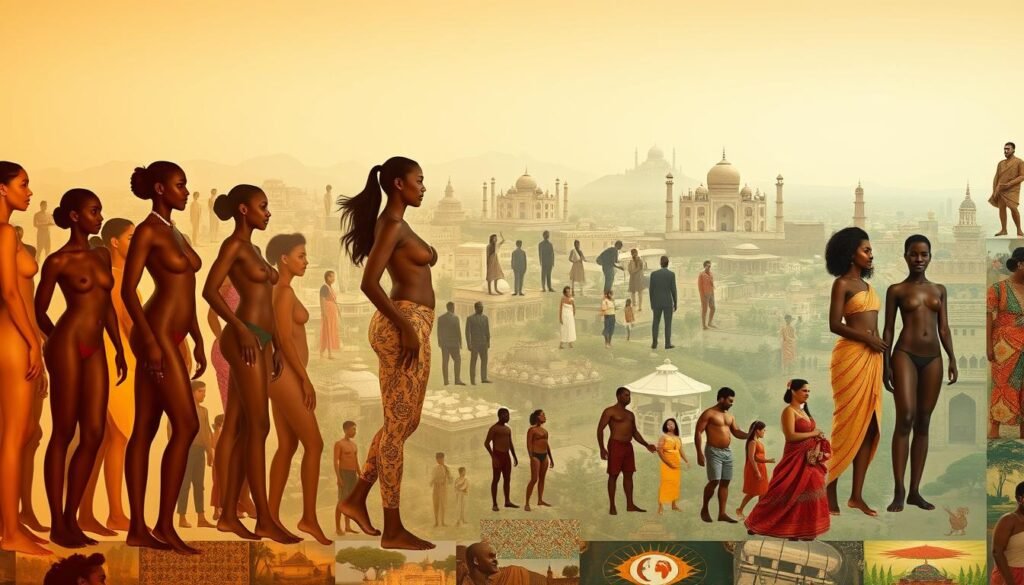Understanding global perspectives on body image is crucial in today’s interconnected world. The perception of body image and its relation to BMI varies significantly across different cultures.
The way individuals perceive their body image can have profound psychological effects, influencing their overall well-being. The media plays a significant role in shaping these perceptions, often promoting unrealistic beauty standards.
To better understand your BMI and other health metrics, you can use our calculators: BMI Calculator, BMR Calculator, and Body Fat Calculator.
Key Takeaways
- Global perspectives on body image vary significantly across cultures.
- The media plays a crucial role in shaping body image perceptions.
- Understanding BMI and other health metrics is essential for overall well-being.
- Cultural differences impact how individuals perceive their body image.
- Using health calculators can provide valuable insights into your health metrics.
Understanding Body Image: A Global Perspective
Understanding body image requires a nuanced approach, considering the cultural context in which it is perceived. Body image is not just about how we see ourselves; it’s also about how our bodies are perceived by others in our cultural environment.
Definition and Importance of Body Image
Body image refers to the perception an individual has of their own body, encompassing their thoughts, feelings, and behaviors related to their physical appearance. It is crucial because it can significantly impact an individual’s self-esteem, mental health, and overall well-being. A positive body image can enhance one’s confidence and quality of life, while a negative body image can lead to issues such as low self-esteem, depression, and eating disorders.
For individuals looking to assess their body mass index (BMI), a useful tool is the BMI Calculator UK, which provides a straightforward way to determine one’s BMI. Similarly, the Ideal Weight Calculator can help individuals understand their ideal weight range.
Psychological Effects of Body Image
The psychological effects of body image are profound. Individuals with a positive body image tend to have higher self-esteem and better mental health outcomes. Conversely, those with a negative body image may experience anxiety, depression, and other mental health challenges. The media plays a significant role in shaping these perceptions, often presenting unrealistic beauty standards that can lead to body dissatisfaction.
The Role of Media in Shaping Body Image
The media has a powerful influence on body image, with advertisements, television shows, and social media platforms often promoting certain beauty ideals. These portrayals can affect how individuals perceive their own bodies and can contribute to body dissatisfaction, particularly if the media representation is unrealistic or unattainable.
| Cultural Context | Media Influence | Body Image Outcome |
|---|---|---|
| Western Cultures | Often emphasizes thinness and muscularity | May lead to body dissatisfaction and low self-esteem |
| Eastern Cultures | Varied, with some cultures valuing modesty over physical appearance | Can result in a more positive body image due to different beauty standards |
| Indigenous Cultures | Traditionally less influenced by Western media ideals | Often have a more holistic view of body image, focusing on health rather than appearance |
Understanding these dynamics is crucial for promoting a positive body image across different cultures. By recognizing the diversity in body perception and the factors that influence it, we can work towards creating a more inclusive and supportive environment for individuals of all backgrounds.
BMI: A Universal Metric or Cultural Construct?
As a widely adopted metric, BMI has sparked debates on its universality and cultural sensitivity. Body Mass Index (BMI) is a simple index of weight-for-height that is commonly used to classify underweight, overweight, and obesity in adults.
What is BMI and How is it Calculated?
BMI is calculated by dividing a person’s weight in kilograms by the square of their height in meters (kg/m2). For instance, an adult who weighs 65kg and is 1.72m tall has a BMI of 22 (65/1.722).
To make it easier for individuals to determine their BMI, online calculators are available. You can use this BMI Calculator for Men or this BMI Calculator for Women to get your BMI.
Critiques of BMI as a Measure of Health
Despite its widespread use, BMI has several limitations. Critics argue that it:
- Does not differentiate between lean body mass and body fat.
- Fails to account for the distribution of fat.
- May not be accurate for non-European populations.
As Dr. Keith Devlin, a mathematician and philosopher, notes, “BMI is a crude measure that doesn’t take into account muscle mass or body composition.” This critique is echoed by many health professionals who argue that BMI should be used in conjunction with other health metrics.
Cultural Interpretations of BMI
The interpretation of BMI varies significantly across cultures. For example:
“In some cultures, a higher BMI is associated with wealth and prosperity, while in others, it is seen as a sign of poor health.”
These cultural interpretations highlight the need for a nuanced understanding of BMI. As global health initiatives aim to address obesity and underweight issues, understanding global BMI variations and adhering to international body standards becomes crucial.
In conclusion, while BMI is a useful tool, its limitations and cultural interpretations must be considered. By understanding these factors, healthcare providers can offer more personalized and culturally sensitive advice.
Regional Variations in Body Image Perceptions
Regional variations in body image perceptions highlight the complex interplay between cultural norms, societal expectations, and individual self-perception. The diverse ways in which body image is perceived across different cultures underscore the importance of understanding these variations to promote a more inclusive and accepting view of body image globally.
Body Image in Western Cultures
In Western cultures, there is a prevailing emphasis on thinness as a beauty ideal, particularly for women. This cultural narrative is perpetuated through media representations that often glorify slender body types. However, there is also a growing movement towards body positivity and acceptance of diverse body types in these cultures.
Key aspects of body image in Western cultures include:
- The influence of media on body image perceptions
- The role of societal expectations in shaping beauty ideals
- The emergence of body positivity movements

Body Image in Eastern Cultures
Eastern cultures, such as those found in many Asian countries, have different beauty ideals that often emphasize modesty and restraint. For instance, in some cultures, a fuller figure is associated with prosperity and good health. However, with globalization, Western beauty standards are also having an impact on body image perceptions in these regions.
The cultural significance of body image in Eastern cultures can be seen in:
- The traditional association of body size with social status
- The influence of cultural and religious beliefs on body image
- The impact of modernization and globalization on beauty standards
Indigenous Perspectives on Body Image
Indigenous cultures around the world have unique perspectives on body image that are deeply rooted in their traditional beliefs and practices. For example, some Indigenous cultures view the body as a connection to their ancestors and the natural world, promoting a holistic view of health and well-being.
For readers interested in understanding body image in children, the Pediatric BMI Calculator is a valuable resource that can provide insights into healthy growth and development.
Factors Influencing Body Image Across Cultures
The perception of body image is influenced by a complex array of factors that vary significantly across different cultures. These factors interplay to shape how individuals perceive their bodies and themselves.
Socioeconomic Status and Body Image
Socioeconomic status (SES) is a significant factor that influences body image. In many cultures, a higher SES is associated with a leaner, more toned body ideal, often due to the cultural capital associated with having the means to maintain such a physique. Conversely, in some cultures, a higher body mass is seen as a sign of wealth and prosperity. For instance, in certain African cultures, being overweight is sometimes associated with beauty and affluence.
To understand the relationship between SES and body image, it’s essential to consider the broader societal context. For example, in societies where food scarcity is a historical or ongoing issue, having a larger body size may be perceived as a status symbol. In contrast, in affluent societies, the prevalence of dieting and weight loss efforts can be linked to the cultural ideal of thinness.

Cultural Significance of Body Types
Different cultures attribute varying levels of significance to different body types. For example, some cultures idealize curvaceous figures, while others prefer more slender physiques. These preferences are often rooted in cultural and historical contexts. For instance, the hourglass figure is often associated with femininity in many Western cultures, whereas in some Asian cultures, a slimmer figure is considered more attractive.
The cultural significance of body types can also be influenced by traditional practices and beliefs. For example, in some Indigenous cultures, body image is closely tied to spiritual and communal identity, rather than individualistic ideals of beauty.
The Impact of Globalization on Body Image
Globalization has led to the dissemination of Western beauty standards across the globe, influencing body image perceptions in diverse cultural contexts. The proliferation of media and social media platforms has resulted in the global spread of certain body ideals, often promoting a thin or muscular body type as the standard of beauty.
However, globalization has also facilitated the exchange of diverse cultural practices and beauty standards, potentially promoting a more inclusive understanding of body image. For those interested in exploring alternative measures of health and body composition, tools like the Waist-to-Height Ratio Calculator can provide additional insights.
Addressing Body Image Issues: Moving Towards Inclusivity
Understanding cultural differences in body image and BMI around the world is crucial for promoting a positive and inclusive global community. As we have seen, body image perceptions vary significantly across cultures, influenced by a complex array of factors including socioeconomic status, media representation, and cultural significance of body types.
Promoting Positive Body Image
Initiatives that foster positive body image are essential. These include campaigns that challenge traditional beauty standards and promote diverse representations of beauty. Organizations such as the National Eating Disorders Association (NEDA) and the Body Positive Movement are at the forefront of these efforts, working to create a more inclusive environment.
Education and Awareness
Education plays a vital role in body image awareness. By incorporating body positivity into educational curricula, we can empower individuals, especially young people, to develop a healthy and positive relationship with their bodies. This education can help mitigate the negative impacts of societal beauty standards.
Future Directions
Looking to the future, it’s clear that promoting body positivity across cultures requires continued effort and innovation. By embracing cultural differences in body image and BMI, we can work towards a more inclusive understanding of beauty and health. This involves ongoing research, community engagement, and collaboration with diverse stakeholders to create a world where everyone can feel valued and respected, regardless of their body shape or size.



